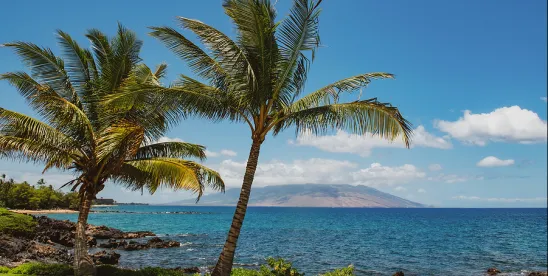Governments are increasingly discussing climate change, including resilience to climate impacts and how to promote the energy transition. Less common are governmental commitments to take concrete steps to address climate change issues, such as the one the State of Hawaii recently reached as part of a settlement in the Navahine F. v. Hawaiʻi Department of Transportation constitutional climate case.
“Constitutional” climate cases — far less common in terms of numbers filed than climate-related cases alleging violations of common or statutory law — are cases rooted in rights granted by a state or federal constitution.
The first-of-its-kind settlement, which does not require any monetary payment, is available here. It obligates Hawaii’s Department of Transportation (HDOT) to develop a plan for the state’s transportation sector to reach net zero greenhouse gas (GHG) emissions across ground transport and inter-island sea and air transportation network by 2045. The 2045 goal aligns with a date chosen by Hawaii’s legislature as their target for this sector to reach net zero. The settlement likewise contains various public participation requirements, under which committees are established with members of the plaintiff group given participation rights and aspirational goals for what funding HDOT will request in the future from Hawaii’s legislature. The court retains jurisdiction over the matter until HDOT completes its obligations under the agreement.
Below, we provide background about the litigation, discuss the terms of the settlement, and outline how the settlement fits into the larger picture of government efforts to address climate issues.
While the regulated community should be aware of the settlement, that Hawaii settled this case (as opposed to litigated it through its conclusion) may result from Hawaii’s unique potential to be affected by climate change and state regulators correspondingly attuned to working to mitigate issues. Further, one could argue that much of the settlement merely requires Hawaii officials to take steps they were already inclined to take outside of the litigation, or one could see the settlement as being consistent with settlements in other institutional reform cases where aspirational goals are paired with process-oriented reforms.
Litigation Background
Hawaii courts have adopted a variety of progressive positions in climate change in recent years. In November 2023, the Supreme Court of the State of Hawaii decided City and County of Honolulu v. Sunoco LP, whichallowed tort litigation against various oil and gas producers to proceed. (For more, see here). And in April 2023, a concurrence in In re Hawai’i Electric Light Company, which rejected a power purchase agreement on process grounds, emphasized “that the right to a life-sustaining climate system is … included in the due process right to ‘life, liberty, [and] property’” enumerated in the Hawaii state constitution as well as the “public trust doctrine” embodied in other sections of the same document. The concurrence opined that climate change is an emergency that poses “the single greatest threat to the natural environment and human societies that ‘the world has ever experienced.’”
Navahine F., originally filed by 13 children ranging in age from 9 to 18 in June 2022 before the above decisions were issued, argued that HDOT has prioritized building highways over other forms of transportation. The plaintiffs argued that these efforts violate provisions of the Hawaii constitution, including a constitutional right to a clean and healthful environment, which incorporates the public trust doctrine that requires Hawaii’s natural resources to be preserved “for the benefit of present and future generations.” Navahine F. raises “generational equity” issues by alleging that climate-related harms disproportionately affect younger people both because climate-related issues are likely to proliferate over time and also because issues like increased temperatures in the environment affect children differently than they do adults.
The settlement builds on precedent, including In re Maui Elec. Co., a 2022 decision by the Hawaii Supreme Court finding that there is scientific consensus that “anthropogenic global warming threatens the world’s climate systems. It raises the seas; it sickens the planet. It harms present and future generations.” Similarly, the settlement recognizes Hawaii legislative findings that direct that “the State needs to plan ahead and understand the steps that need to be taken to create a carbon-negative economy by 2045.”
The settlement was reached on the eve of trial. It requires Hawaii to develop a plan under which its transportation sector can become carbon-neutral and to achieve zero net GHG emissions by 2045, a date previously recognized as a goal by the Hawaii legislature. Other terms of the settlement include the following:
- Within one year of the settlement, HDOT will complete a “concrete and comprehensive statewide plan” to reduce GHG emissions “on a timeline that complies with” specified provisions in Hawaii state laws requiring the state to increase energy efficiency in the transportation sector, both public and private. The plaintiffs and the public would have at least 30 days to comment on this plan, and these comments would be considered before the plan’s finalization.
- That HDOT’s plan will incorporate targets for the years 2030, 2035, and 2040, leading to the full decarbonization of the statewide transportation sector, and include the consideration of plans for investments in infrastructure for the “full decarbonization of the international aviation and marine transportation” to Hawaii.
- That HDOT will create a new unit headed by a Climate Change Mitigation and Culture Manager, who will “integrate and coordinate the mission of GHG reduction throughout HDOT” and serve as a liaison with plaintiffs throughout the process, and a “volunteer youth council to advise on HDOT’s mitigation and adaptation commitments on a quarterly basis, with transparency about youth council recommendations and HDOT’s responses.” The plaintiffs would initially have “at least” two of the youth council seats allocated to them.
- That HDOT will accelerate the expansion of the public electric vehicle (EV) charging network, HDOT will seek to increase budgeting for charging infrastructure, with a goal of investing a minimum of $40 million into public charging stations by 2030, as part of the reduction plan.
- That HDOT will seek to complete pedestrian, bicycle, and transit networks in coordination with counties as already contemplated by Hawaii state law, with a goal of completing the work within five years.
Settlement Context
While this settlement alleging climate-related harm to youth is unprecedented, Hawaii may be a special case. Two compelling factors likely explain why Hawaii is playing a significant role on this issue:
- Hawaii is an island. Climate change — and particularly impacts related to storms and sea-level rise — have a greater potential to affect Hawaii than landlocked states. Internationally, the International Tribunal for Law of the Sea’s (ITLOS) advisory opinion was submitted by the Commission of Small Island States on Climate Change and International Law. ITLOS found that international law compels most states to take concrete actions to address harms posed by climate change. Like the settlement here, the ITLOS panel declined to specify at this time what actions were required. (For more on this decision, see here).
- All three branches of the Hawaii government had previously recognized the need to address climate-related issues in a systematic way, favoring more comprehensive legislation regarding climate change. The unanimity in Hawaii contrasts with more fractured support for engagement on climate issues in other jurisdictions, including the US federal government.
Because this is the first settlement in a generational equity case in the United States, it may encourage other plaintiffs to file similar claims. Until now, the two main generational equity climate cases were Held v. State of Montana (see here) and Juliana v. United States, which was dismissed in May by the Ninth Circuit. In Held, a group of young plaintiffs were successful in arguing for the narrow proposition that the Montana Legislature’s attempt to carve climate issues out of Montana’s “Green Amendment”-type language was constitutionally impermissible. This argument succeeded because the law would have eliminated Montanans’ constitutionally granted right to relief necessary to protect the environment. While the young plaintiffs in Juliana were ultimately unsuccessful in securing court relief, their claims remained alive long enough to encourage plaintiffs in other places like Hawaii to file similar litigation.
Finally, it is worth noting that it is inherently difficult for plaintiffs to win policy-related institutional reform litigation. The Juliana plaintiffs were eventually compelled to seek declaratory relief when the Ninth Circuit found that their requested relief was beyond the power of the court to provide. The tension of courts directing executive agencies to spend money which has not yet been allocated by the relevant legislature is one that has stymied institutional reform plaintiffs in civil rights, foster care, and other areas for generations. (For more, see here).
What to Watch Next
Years will pass before we know how — and even whether — Hawaii will fully meet the conditions of the settlement. Those years will likely include plaintiffs filing other climate-related cases seeking relief in areas as diverse as tort, constitutional law, and for environmental, social, and governance- (ESG) related theories like greenwashing.




 />i
/>i
